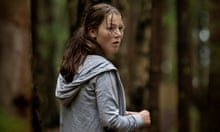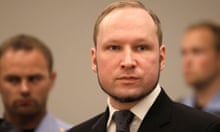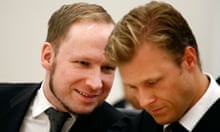When Anders Behring Breivik announced in the spring of 2011 that he was moving out of Oslo to become a farmer, his friends were pleased.
After five years dossing about unemployed at his mum's flat, including 12 months playing video games day and night, Breivik finally appeared to have found some direction.
In April 2011, just before he left the capital, the then 32-year-old hosted a barbecue for six friends. He was upping sticks to a farm near Rena, a town two hours north-east of Oslo, to grow sugar beet, he said. It was a bit of a curveball, but not totally out of character.
Breivik, after all, was a man whose professional life had already taken some unusual twists, including an unsuccessful trip to Liberia to buy blood diamonds and a business selling fake degree certificates.
"I thought it was good that he moved out of his mother's house," one of his friends, a fireman, told Oslo central court. Breivik appeared to have regained his "spark" and his friends were relieved. They had worried about his increasingly erratic behaviour.
At a party earlier in the year, he had announced he was not drinking as he was taking anabolic steroids and he had been banging on about Muslims "seizing power" in Norway. Then there was the book he had been writing about the Islamification of Europe, plus the mysterious nose job, undergone, apparently, after someone accused him of having an "Arab nose". One friend said he had never been the same after being jilted by a Belarusian girl he had met online.
Others thought he was struggling with his sexuality after he started wearing makeup.
In June last year, another friend, a lawyer, remembered meeting him in a cafe, where Breivik talked about the government subsidies available for farmers. "I thought perhaps he had now emerged from his depression," said the lawyer.
Little did they know that what Breivik was cultivating on the isolated farmyard was not sugar beet but a lethal bomb, which would kill eight people and injure more than 200 others.
Curious about his rural life, they kept trying to visit but Breivik fobbed them off.
"For natural reasons I had to do everything I could to avoid this from happening," Breivik told the court. "Gradually there was more pressure; they would say 'Why do you not want us to come up there?'
On a couple of occasions they tried to drive up and a couple of times I had to turn off my mobile to avert visits … Only thing that went in my favour was there was no street address for the farm so they didn't find out where it was."
Had the friends found the farm, they would have discovered Breivik in a chemical warfare suit, grinding up ammonium nitrate pills using four kitchen blenders – a technique he said he had copied from Andreas Baader of the Red Army Faction, the German terror group also known as the Baader Meinhof gang. Or perhaps strapping himself up with rucksacks, one front and one back, each containing 30kg of rocks, ready to go out training to build up his strength for what he anticipated would be a physically strenuous "mission".
If they had arrived one afternoon during a storm they might have found him a mile away from the farm, waiting for a thunder clap so he could detonate a test charge.
Breivik had thought of everything, each tiny detail that ensured his plan could be executed with dreadful accuracy. There was the "sorry: sewage works" sign he put in the window of the rented van he loaded with explosives and parked in Oslo city centre the day before the attacks ("I was very concerned about passersby. These are chemicals that have a very strong smell."); the parking ticket he remembered to buy for the Fiat Doplo he used as a getaway car; the precise calculation on how many acres of farmland he would need to rent to justify the quantities of fertiliser he would be ordering.
But perhaps the worst manifestation of Breivik's scrupulous attention to detail was the police uniform he bought on the internet and then wore to sail to the island of Utøya, having called ahead and convinced one of the adults running the annual summer camp of the ruling Labour Party's youth wing that he had been sent to reassure the teenagers in the aftermath of the Oslo bombings. They sent over a ferry to pick him up. An hour and 20 minutes later he had shot dead 67 of those people he claimed he had been sent to protect; one 17-year-old fell off a cliff and died trying to dodge Breivik's bullets. Another, also 17, drowned trying to escape.
He'd had enough time to mull things over. By his own account, his twin attacks that left 77 dead had been five years in the making. The prosecution could find evidence of two years of determined planning: membership of an Oslo shooting club, jaunts around Europe buying guns and ammunition, internet transactions for fertiliser, military uniforms and other equipment.
Breivik claimed he started plotting the attacks in earnest in 2006. After winding up his business ventures, he moved out of a shared flat and back in with his mother, Wenche Behring, who was single again after the breakup of her third marriage; her second, to Breivik's father, Jens, had gone sour when Breivik was just one.
In the summer of that year, Breivik announced he was going to take a sabbatical to play the role-playing computer game World of Warcraft full-time. He deserved a break, he said, after four years working "12–14 hour days". Since dropping out of school, when not working in a call centre, he had cooked up various entrepreneurial schemes, including the lucrative fake diploma scam and a number of less successful companies selling telephone marketing services and outdoor advertising space.
"Some people take a year off playing golf. I wanted to take a year off to play World of Warcraft," he told the court. "Especially bearing in mind the upcoming so-called suicide action … I wanted to have no remorse as to what I had missed out on."
It was all part of his desensitisation plan, he insisted, of removing himself from normal life so that he could transform himself into a cold-blooded killer. "In many ways it is a protection mechanism," he said. "If you are going to be capable of executing such a bloody and horrendous operation, you need to work on your mind, your psyche, for years. We have seen from military traditions you cannot send an unprepared person into war."
His family and friends fell for his cover story, he said. "I played on the idea that 'Ooh, I've become addicted to games'." His sister, who lived in Los Angeles, thought he was in "deep trouble, a games addict", said Breivik. His mother was aghast, which was, he said, "a fairly normal, healthy reaction. It would have been quite abnormal if she had just said, 'Oh, that's great, go ahead'. I couldn't tell her I was taking a sabbatical because I was going to blow myself up in five years' time."
Under cross examination, Breivik admitted his mother was his "achilles heel" and "the only one who can make me emotionally unstable". He told the court he would urge his mother, a solitary woman, to find a hobby, but she would tell him, "You're my hobby".
Wenche Behring had been called as a witness for the prosecution but did not attend court after being signed off by a doctor. She told psychiatrists assessing her son's mental health that he acted strangely after moving back in with her, sometimes sitting on top of her on the sofa or attempting to kiss her face. In a statement to police read out in court, she said: "I felt like I was in prison with him. He was uncomfortably intense. He started saying I was a Marxist and a feminist. From 2010 he became really strange." The court heard how she had been frightened of him as a small boy. When he was just four, she called in social workers who wanted to remove the disturbed boy and put him in a foster home to prevent any further psychological disintegration.
Breivik always claimed that while he operated as a "one-man cell" in order not to be "flagged" by the security services, he was a member of a shadowy cadre of anti-Islamists called the Knights Templar (KT).
When he finally called police to surrender on Utøya, he introduced himself to the telephone operator as "Commander of the Knights Templar Europe – we are organised in the anti-communistic and Norwegian resistance movement against the Islamisation of Europe and Norway."
He claimed to have been at the group's inaugural meeting in London in April 2002, a pow-wow the prosecution do not believe ever happened, even though Border Agency data showed he was in the UK at that time. Investigators believe KT "does not exist", at least not in the way Breivik describes it.
In police and psychiatric interviews, as well as in court, he has refused to reveal any details of the group's other members, including a British man whom he calls Richard the Lionheart in the 1,801-page compendium he compiled before the attacks to explain his motives.
Breivik's travels in 2002 were one of the most disputed parts of his trial. Evidence from his passport proved that he had indeed gone to Liberia and then London via the Ivory Coast that spring, but what exactly he was doing there remains unclear.
The prosecution believes he had fallen victim to a Nigerian internet scam and was hoping to get rich quick in the war-torn country by trading in so-called blood diamonds. But Breivik insisted the diamonds were a smoke screen, another cover story. Yes, he had bought diamond-cutting paraphernalia in Oslo and had gathered some Unicef brochures to take in his hand luggage in case he needed to pretend he was an aid worker, he said. But his true purpose was to meet a "Serbian warlord" who, he said, was going to school him in the methods of "militant nationalism" .
It was the Nato invasion of Serbia in 1999 that prompted the foundation of the KT, he said: "That was the straw which broke the camel's back for many brothers who chose to go militant."
But there were also personal experiences on the streets of Oslo that Breivik said contributed to his radicalisation. Though his friends disputed it in evidence, he claimed to have been involved "in around 20 confrontations with Muslims in Norway", including one which left him with a broken nose (hence the rhinoplasty). He had tried to fight against immigration using legitimate means, he said. He joined the Norwegian Progress party, he became a mason, he wrote letters to newspapers that were never printed and was an enthusiastic commenter on internet articles. Until 2006 he had no intention of taking up arms, he insisted, but instead chose to contribute financially to the fight against Islam (hence his money-making schemes).
But in 2006, fed up at being ignored and disgusted by those he described as "keyboard warriors", he resolved to carry out what he called a "mission". With no job to take up his time, he spent months on the internet, practising his shooting on video games and reading voraciously about other terror attacks. He read the English-language media and schooled himself in al-Qaida's terror tactics by using Google Translate to understand terror manuals he found on the internet.
He was particularly interested in the specifics of attacks. He noted that after Timothy McVeigh killed 168 people in the 1995 Oklahoma City bombings, the security services had banned the sale of fertiliser containing 98% ammonium nitrate. "Following that attack, the EU and US governments decided to dilute ammonium nitrate … to 85%," he said, "and there was an understanding among everyone that it would not detonate."
With noticeable pride, he told the court he set himself a challenge to try to make a bomb out of this diluted chemical. Unfortunately, he succeeded.
He was alert to mainstream politics just as much as the fringes, noting that "Sarkozy, Merkel and Cameron have all said that multiculturalism has failed." He had studied recent history and was disgusted to see what happens "any time the nationalist parties take over power". He cited as examples the partial EU boycott after Jörg Haider's far-right Freedom party entered Austria's government in 2000, and the threats being made to the current rightwing coalition in Hungary, which he claimed, was under pressure to "change their mind by being called intolerant nationalist Nazis".
Breivik insisted he was not alone in fighting against "mass immigration". He singled out the National Socialist Underground, the neo-Nazi terror cell revealed last year as being responsible for killing nine immigrants and one policewoman in Germany, and Peter Mangs, the man found guilty last month of carrying out killings over seven years in the Swedish city of Malmö. It is important, he said, that these "heroic young people" should be "celebrated" for "sacrificing" their lives for the "conservative revolution".
The deadly plan he settled on for 22 July was a compromise, he told the court. Originally he had wanted to hit three targets. As well as the government headquarters where he planted the fertiliser bomb, he wanted to hit the Labour party building in central Oslo, as well as a third target – perhaps the royal palace, a well-known squat called the Blitzhuset, the offices of the Aftenposten newspaper or NRK, the Norwegian state-owned broadcaster.
But he had to scale down his plans after making a bomb proved more difficult than he expected. He was having problems synthesising picric acid, a chemical compound used as an explosive. He thought it would take three to four weeks to make three bombs; in the event, it took him three timesas long to make one. Plus he was running out of money, having reached the maximum on 10 of his 11 credit cards.
The time delay meant he missed two other possible targets: the annual conference of Norwegian journalists and the main Labour party congress. He settled on Utøya only reluctantly, he said, knowing that many other militant nationalists would not agree with him killing children. He originally planned his attack to coincide with a visit to the island from Gro Harlem Brundtland, a former Norwegian prime minister. He wanted to decapitate her and film the execution, he said.
But he wasn't ready on time and she was gone when he arrived.
In the end he compromised, hoping merely to wipe out the next generation of liberal politicians on the island that day. "The objective was not to kill 69 people at Utøya. The objective was to kill all of them," he said, adding that he planned to fire shots, scaring the campers into the water where he anticipated they would drown. "The main goal was to use the water as a mass-destruction method. Basically, I assumed most people would drown," he said, adding, that it's "hard to swim if you have death anxiety".
He didn't succeed on that point. But another of his goals has been achieved. He received the public trial he craved. "Your arrest will mark the initiation of the propaganda phase," he wrote in the manifesto he posted online before his killing spree. "Your trial offers you a stage to the world."



